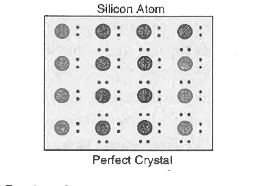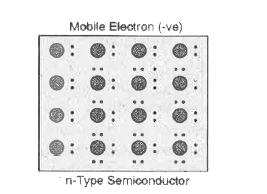What is a semiconductor ? Describe the two main types of semiconductors and contrast their conduction mechanism.
Semiconductors: A semiconductor is a solid that has a conductivity intermediate between that of a conductor and an insulator. The conductivity varies from 10−6 to 104(Ωm)−1. In other words, due to absence of free electrons, solid substance behave as insulator, but at higher temperature it can conduct electric current, because some covalent bonds break.

Types of Semiconductors:
i. n-type semiconductors : It is obtained by doping silicon with a group 15 element. Suppose silicon is doped with phosphorus which has 5 valence electrons. Out of 5 valence electrons, only 4 valence electrons are involved in bond formation, fifth electron is not bond anywhere and can be easily promoted to the conduction band. The conduction is, thus, mainly caused by the movement of electrons. So due to presence of the negative charge such type of semiconductor is called n-type semiconductor.

p-type semiconductors : It is obtained by doping silicon with a group 13 element. Suppose silicon is doped with gallium which has three valence electrons. Three valence electrons form three bonds with neighbouring Si atoms. This gives rise to electron deficient site or positive hole. The movement of the one electron into the vacancy leaves behind a hole which carries a positive charge. The movement of positively charged holes is responsible for the conduction of charge. So, such type of semiconductor is called p-type semiconductor.

Topper's Solved these Questions
- SOLID STATEBOOK - MBD -HARYANA BOARDCHAPTER - SOLID STATEEXERCISE - SHORT ANSWER TYPE QUESTIONS
18 Videos
- POLYMERSBOOK - MBD -HARYANA BOARDCHAPTER - POLYMERSEXERCISE - Long Answer Type Question
9 Videos
- SOLUTIONSBOOK - MBD -HARYANA BOARDCHAPTER - SOLUTIONSEXERCISE - LATQ ( LONG ANSWER TYPE QUESTIONS )
25 Videos
Similar Questions
What is a semiconductor? Describe the two main types of semiconductor and contrast their conduction mechanism.
View SolutionWhat is a semiconductor? Describe the two main types of semiconductor and contrast their conduction mechanism.
View SolutionWhat is a semiconductor? Describe the two main types of semiconductor and contrast their conduction mechanism.
View SolutionWhat is a 'semiconductor' ? Describe the two main types of semiconductors and contrast their condcution mechanisms.
View SolutionWhat is a 'semiconductor' ? Describe the two main types of semiconductors and contrast their condcution mechanisms.
View SolutionWhat is a semiconductor ? Mention the two main types of semiconductor.
View Solution(a) If the radius of octahedral void is r and the radius of the atoms in the close packing is R, derive a relationship between r and R.
(b) What is a semiconductor? Describe the two main types of semiconductors and conductor and contrast conduction mechanism in them.
View SolutionWhat I a semiondutor ? Mention the two main types of semiconductor.
View SolutionWhat is a semiconductor ? Describe two main types of semiconductors and explain mechanism for their conduction.
View SolutionWhat are n-type semiconductors ?
View Solution
